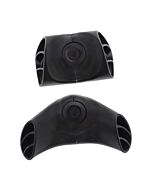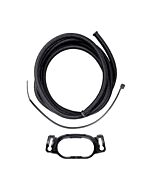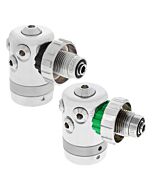Apeks XTX Series Second Stages
- Ultra performance pneumatically-balanced downstream design
- Large progressive two-step purge button, easy-to-locate venturi lever has a soft touch rubber grip
- Innovative user changeable exhaust tee for option of best bubble dispersion or more compact size
- Metal heat exchanger and barrel for excellent cold water tolerance to {36°F | 2°C}
- Options for right or left inlet orientation - user changeable exhaust tee size
Apeks XTX Series Second Stages
When purchased separately, individual regulator stages remain as factory configured by the manufacturer and final integration must, out of necessity, become a customer responsibility.
The Apeks XTX series second stage is an ultra-performance pneumatically-balanced downstream design that results in smooth, easy breathing in even the most extreme environments. A metal heat exchanger which surrounds the valve mechanism, dissipates the cold caused by gas expansion while drawing in and retaining ambient heat. The purge button is large and easy to operate and features two-step progressive operation. Press the purge on the side for a lower flow rate, useful where more control is required such as filling lift bags, then press in the center for the full effect of the purge such as when clearing water. The large venturi lever has a soft touch rubber grip, which makes it easier to locate and use. An optional easy-to-grip opening effort adjustment knob keeps the diver in control at all times.
The XTX second stage design supports an Innovative user changeable exhaust tee. This system gives the diver the ability to change between an exhaust tee that makes the second stage more compact and an exhaust tee that offers the best bubble dispersion. The XTX second stages are also a reversible design that can be converted from a standard right-handed hose inlet configuration to an uncommon left-handed configuration. Apeks describes the process of reconfiguring the regulator to a left-handed hose inlet as both quick and simple, however they recommend this be done by a regulator technician; see Product Attachments tab above for more information.
There are six different styles of the XTX series second stages with variations in the cosmetics †, opening effort adjustment, exhaust tee, and mouthpiece.
- XTX200 Adjustable Chrome - has polished chrome cosmetics and an opening effort adjustment knob (with hex key micro-adjustment feature), plus both the wide and compact exhaust tees, and the popular Apeks Comfo-bite™ mouthpiece.
- XTX50 Adjustable Black - has black cosmetics and includes an opening effort adjustment knob, a wide exhaust tee, and the Apeks Comfo-bite mouthpiece.
- XTX50 Adjustable Yellow - has yellow accent cosmetics and includes an opening effort adjustment knob, a compact exhaust tee, and the Apeks standard mouthpiece.
- XTX40 Non-adjustable Black - has black cosmetics with a compact exhaust tee, and the Apeks Comfo-bite mouthpiece.
- XTX40 Non-adjustable Yellow - has yellow accent cosmetics with a compact exhaust tee, and the Apeks standard mouthpiece.
- XTX40 Non-adjustable Green - has green and yellow accent cosmetics with a compact exhaust tee, and the Apeks Comfo-bite mouthpiece for extra comfort on oxygen accelerated deco with long runtimes.
Regardless, all versions of the XTX series regulators offer identical ultra-performance.
† Just to be clear, the color cosmetics of any XTX Series Second Stage is meaningless in regards to their breathing performance characteristics, cold water tolerance, or oxygen compatibility. All six XTX second stage models are literally identical in regards to those specifications: chrome color does not indicate better cold water tolerance; yellow color does not mean a lower performing configuration; green color does not indicate better suitability for oxygen service.
Although your personal preferences will be the best guide, the XTX200 and XTX50 are normally selected for primary breathing applications while the XTX40 is typically selected for alternate applications. However, some divers prefer the simpler XTX40 non-adjustable compact configuration even for primary applications, see our TekTip below for explanation. The XTX200 second stage is typically mated with the FSR flagship first stage for extreme applications including very cold or contaminated water. The XTX50 second stage is typically mated with the DST swivel turret first stage for general sport and technical diving applications. The XTX40 is often mated with the DS4 fixed port first stage for staging, deco and bailout bottle applications.
The XTX series second stages all have the same industry standard intermediate pressure range between {130 psi | 9 bar} and {145 psi | 10 bar} and 9/16-18 UNF male thread hose inlet along with ambient outlet { 1.3 x 0.68 in | 3.3 x 1.7 cm } orifice dimensions. Apeks offers their branded accessories for frequently seen customizations that include: Changing the exhaust tee configuration. Changing the mouthpiece style or color, especially for coding purposes. Adding a bungee necklace to primary backup configurations. Adding a lip shield for diving in freezing cold water. Adding a flow stop to help protect against critical gas loss scenarios.
| Brand | Apeks |
|---|---|
| SKU | APX-XTX-2ND |
| Weight | 1.000000 |
Customer Reviews
YOU MAY ALSO BE INTERESTED IN THE FOLLOWING PRODUCT(S)
What is the knob and lever on my second stage?
The knob and lever are used to alter the breathing characteristics of some types of regulator second stages. All our downstream design high performance second stages, including the DGX Xtra and D6, Dive Rite XT2 & XT4, MaresXR HR, and the Apeks XTX200 & XTX50 include a knob to adjust inhalation cracking pressure (aka opening effort.) Some second stages, including the DGX Xtra and D6 along with the Dive Rite XT2 & XT4 and all the Apeks XTX Series, offer a lever to disable/enable venturi assisted inhalation. The Mares XR HR/VR/SXS stages use a unique Vortex Assisted Design (VAD) system that does not require a venturi lever. Upstream designs with a servo-assist valve, such as the Poseidon Xtreme, don't normally incorporate these features because the design inherently obviates most of the need for them. Many special application designs that are light duty, such as backup (aka 'octo', 'safe second', 'alternate', 'oxygen') and BCD integrated second stages, may omit the diver adjustable cracking pressure and/or the venturi assist features for the sake of simplicity.
The knob is for diver adjustment of the cracking pressure (aka opening effort) which is the inhalation force it takes to trigger the second stage valve to open and begin to flow breathing gas to the diver. Some people might refer to this as the 'breathing resistance' but this is a misnomer because once the gas starts flowing, adjusting the cracking pressure during inhalation will have minimal effect. On most high performance designs turning the knob all the way out (counter clockwise) will cause a slight hiss or dribble of free flowing gas and turning it all the way in (clockwise) will make it difficult to breathe from the regulator. Start by setting the knob in the middle of the adjustment range and then turn the knob to set the cracking pressure to your personal preference. Some divers will occasionally adjust it during the dive based on changes in their physical effort and depth, but most divers find a setting they like and never feel a need to change it. †
Many high performance second stage designs include a venturi assist feature that reduces breathing resistance by automatically increasing gas flow during inhalation. Regulators with the venturi assist enabled are prone to free flow if the second stage is not in the mouth. The venturi lever set in the pre-dive position (-) will substantially eliminate the tendency to free flow. Second stages in pre-dive mode WILL deliver breathing gas, but with some increased breathing resistance because the venturi assist feature has been disabled. On the primary second stage, you should push this lever in to the dive position (+) when you put the regulator in your mouth. On second stages not in the mouth during the dive the switch remains in pre-dive position; should circumstances require its use while in-water, once breathing from the regulator just switch the lever from pre-dive to dive mode.
The knob and the lever have related yet different functions, the knob determines how easy it is to start the breathing gas flowing to the diver and the lever determines how easy it is to maintain the breathing gas flow. Some lever designs are {predive| dive} with little or no range of adjustment to the venturi effect, however the adjustment knob by design always has a significant range of settings. Both can be set to minimize the possibility of free flow.
Some divers (especially those who use a breathing pattern called 'skipping') incorrectly believe that by using the adjustments to decrease the regulator performance they will conserve gas. In fact, improperly adjusted second stages have the opposite tendency to cause most divers to retain CO2 and increase their respiration rate thus gas usage while at the same time causing some discomfort and/or headache.
† You might be surprised to learn some experienced divers dislike having an adjustment knob on their second stage. They view the knob as an unnecessary option that is thought to be more of an entanglement hazard, certainly adds to the cost of the regulator and some just prefer a more streamlined second stage. Unnecessary? Yes, even when there is no external knob, the cracking pressure on downstream designs is always adjustable internally. This an easy skill to learn, beneficial to know, and there are videos on the internet to show you how.

















